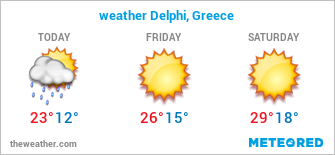
Delphi Archaeological Museum inauguration in 1905
A first, small museum was inaugurated on 2 May 1903 to celebrate the end of the first great archaeological campaign of French excavations and to hold the discoveries.
The building was designed by the French architect Albert Tournaire, financed by a trust by the Greek banker and philanthropist Andreas Syngros and built in the location where it remains to this day, although it has since been entirely transformed. Two wings framed a small central building.
The Omphalos: the Navel Stone symbolizing the Centrer of the World at Delphi. (11-13 octobre 1913. Autochrome by Auguste Léon, Département des Hauts-de-Seine, musée Albert-Kahn, Archives de la Planète, A 1 379)
Dancers of Delphi, also known as the Acanthus Column. (picture 11-13, October 1913). 12 octobre 1913, (Autochrome, ), Auguste Léon, Département des Hauts-de-Seine, musée Albert-Kahn, Archives de la Planète, A 1 408
The arrangement of the collection, designed by the head of the archaeological expedition, Théophile Homolle, was inspired by the view that the architectural parts found should be put “in context”.
Statue of Antinoos, the favori of Roman emperor Hadrien. (picture 11-13, October 1913. Autochrome, 12 x 9 cm).
The focus was set on the restoration of the principal monuments of the site with plaster, in order to display the discoveries in a more accessible way. Thus, it lacked any chronological or thematic arrangement.
The quality of the exhibits themselves was thought to be self-explanatory. Furthermore, the exhibits took every inch of available space, not letting enough room for the appreciation of the antiquities.
Renovations
In the 1930s, although the museum had achieved undeniable success with the international public, it was becoming too small to hold the new discoveries on the site or the increasing number of tourists. In addition, its arrangement (or absence of arrangement) and the plaster restorations were increasingly criticised. Finally, its appearance was criticised as a little too “French” in a period which insisted on “Greekness”.
In 1935, the construction of a new building was launched. It took three years. The new museum was, like its predecessor, was representative of the architectural trends of its time. The work, including a new arrangement of the objects by the Professor of Archaeology at Thessaloniki, Konstantinos Romaios, was completed in 1939.
The reorganisation of the Archaic collections was entrusted to the French archaeologist Pierre de La Coste-Messelière, who discarded the plaster restorations of significant artefacts, including that of the Siphnian Treasury, which had become the principal attraction. The antiquities were presented in a chronological order, catalogued and labelled.
However, this arrangement was only briefly in use. The outbreak of World War II constituted a major threat to the antiquities which were put into storage. Part was kept at Delphi in the ancient Roman tombs or in specially dug pits in front of the museum. The most precious objects (the chryselephantine objects, the silver Statue of a Bull discovered three months before the outbreak of war and the Charioteer) were sent to Athens in order to be stored in the vaults of the Bank of Greece.
They remained there for ten years. The charioteer was on display in the National Archaeological Museum of Athens until 1951. The region of Delphi was at the heart of the combat zone in the Greek civil war and the museum was not reopened until 1952.
For six years, visitors could view the arrangement that had been envisioned in 1939. However, the museum proved insufficient and it was necessary to undertake a new phase of construction, completed in 1958.
The renovation of the museum was entrusted to the architect Patroklos Karantinos and the archaeologist Christos Karouzos was sent from the National Archaeological Museum of Athens to rearrange the collection, under the supervision of the ephor of Delphi, Ioanna Konstantinou. Karantinos created two new exhibition halls and modified the structure to allow more natural light into the building. The arrangement of the collection remained chronological, but a greater focus was placed on the sculpture, with statues increasingly separated from their architectural contexts.
The museum reopened its doors in 1961 and it became one of the most visited tourist attractions in Greece: in 1998, it received more than 300,200 visitors, almost as many as the National Archaeological Museum of Athens in the same period (325,000 visitors).

Between 1999 and 2003, the museum underwent yet another phase of renovations, carried out by the Greek architect Alexandros Tombazis. These included the construction of a new facade in a contemporary style and a new hall for the charioteer. The rest of the museum was redesigned in a modern style and adjusted to facilitate the circulation of visitors. A new lobby, a large cafeteria and a gift shop were also created.
The collection was rearranged in order to reconcile the need to display the main attractions of the museum effectively and the wish to present the latest theories and discoveries of archaeological and historical scholarships. An effort was also made to illustrate hitherto neglected exhibits like the classical facade of the Temple of Apollo. The museum opened its doors once more for its centenary.









